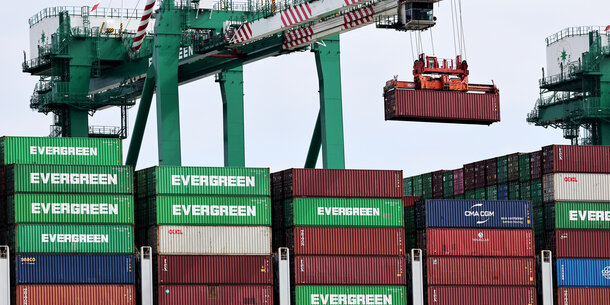The Supreme Court will soon decide whether to issue an emergency stay of a judge’s order barring the president’s attempted deployment of federalized National Guard forces in Chicago. There are two models the Court could follow: the ruling of the Seventh Circuit Court of Appeals, which upheld the order in question, or two rulings by the Ninth Circuit, which froze similar orders in Los Angeles and Portland.
The stakes could not be higher. The general rule against using the military as a domestic police force — reflected in both law (the Posse Comitatus Act) and centuries-old tradition — is one of the most important protections we have in this country for democracy and individual liberty. An army trained to fight and destroy overseas enemies, if turned inward against the people, could become a powerful tool to suppress dissent and undermine rights.
Congress has passed laws that allow domestic deployment of the military in extreme circumstances — a power that previous presidents have used sparingly. In the last nine presidencies (not including the first Trump administration), presidents have deployed troops to quell civil unrest or enforce the law only twice. By contrast, Trump has either authorized or requested deployment of troops in American cities five times in four months. That fact alone should set off alarm bells.
In the Seventh Circuit, the court upheld the district judge’s conclusion that the facts on the ground simply did not justify deployment. In the Ninth Circuit, however, the court has now twice accepted the alternate reality put forward by the administration.
If the Supreme Court adopts the Ninth Circuit’s approach, it would give President Trump the green light to deploy troops throughout the nation in response to protests against his policies. At the bottom of this slippery slope is a nation in which fundamental freedoms are no longer guaranteed.
The Seventh Circuit’s Ruling in the Illinois Case
At a U.S. Immigration and Customs Enforcement facility outside Chicago, protests against ICE policies — typically involving fewer than 50 people and never more than 200 — involved occasional acts of violence or obstruction by protesters. Federal and local law enforcement officers responded to these incidents, with state and local police making several arrests. The ICE facility remained open and functioning throughout.
Trump’s threats to send the military into Chicago long predated these protests, as he had frequently floated the idea of deploying troops to address crime in the city. In a September social media post, he depicted Chicago in flames accompanied by the words “Chipocalypse Now” and “Chicago about to find out why it’s called the Department of WAR.”
After the protests began, Trump switched to a new justification. He authorized the federalization of 300 Illinois National Guard soldiers under 10 USC § 12406, a law that permits federalization when (among other triggers) the president is “unable with the regular forces to execute the laws of the United States.” The theory was that the actions of some protesters had rendered ICE “unable” to enforce immigration law.
The state of Illinois filed suit and asked Judge April Perry for a temporary restraining order to block deployment. The threshold question Perry faced was how much deference to give the president’s decision to invoke the law. The administration argued that the court could not review the president’s actions under Section 12406 — full stop. Perry acknowledged that the president should receive substantial deference on the question of whether the facts justified deployment, but she rejected the notion that judicial deference must be absolute.
Before reaching the president’s assessment of the facts, though, Perry had to determine what the facts were. There was a marked discrepancy between the version of events put forward by the state and local police departments on the one hand and the Department of Homeland Security on the other. The state’s declarations described sporadic incidents that were quickly resolved by federal, state, and local law enforcement. DHS, however, “report[ed] significantly more violence in the Chicago area.”
Perry thus had to decide which account was more credible. She found that all three of the relevant declarations submitted by DHS had either a mistake or a material omission. For instance, two declarations asserted that armed individuals assaulted ICE officers, but left out the fact that grand juries refused to indict at least three of those individuals for lack of probable cause. The judge concluded that the state’s presentation of facts was more reliable.
Of course, the critical question under Section 12406 is not what the protesters did, but what effect their actions had — specifically, whether they rendered the president “unable” to execute the law without federalizing the Guard.
As Perry found, there was simply no evidence that ICE was significantly impeded, let alone “unable” to carry out its activities. To the contrary, DHS issued a press release boasting that protests had not slowed ICE down and touting a significant increase in its deportation and arrest numbers. The judge concluded that “the factual conditions necessary for President Trump to have properly invoked Section 12406[] simply do not exist,” and she issued a temporary restraining order prohibiting deployment of Guard forces.
A three-judge panel of the Seventh Circuit — including a Trump appointee and a George H.W. Bush appointee — unanimously refused the administration’s request to stay Judge Perry’s order pending appeal. The panel found that there was no clear error in Judge Perry’s findings of fact, as would be necessary for an appellate court to overturn those findings.
The Ninth Circuit’s Ruling in the California Case
The rulings of the Ninth Circuit in the lawsuits brought by California and Oregon present a stark contrast to the ruling of the Seventh Circuit. In the Ninth Circuit cases, two different panels turned a blind eye to the gulf between the undisputed facts and the president’s determination that he was “unable to execute the laws of the United States” without National Guard forces.
In Los Angeles, ICE began a series of raids on June 6. The raids sparked protests involving several hundred people in isolated parts of the city. While the protests were mostly nonviolent, there were multiple instances of violence and vandalism. Local law enforcement responded swiftly and aggressively to these instances and announced that they had the situation under control.
Nonetheless, just one day after the protests began, Trump issued a memorandum authorizing the federalization and deployment of National Guard forces. Two thousand members of the California National Guard were federalized and deployed to Los Angeles the next day, finding the city quiet upon their arrival.
California filed suit. Judge Charles Breyer, while accepting the facts presented by the administration, found that ICE was not “unable” to execute the law. A panel of the Ninth Circuit stayed his temporary restraining order. Notwithstanding the language of Section 12406, the panel held that inability to execute the law was too high a bar. Applying a highly deferential standard of review, it concluded that the violent actions taken by some protesters were sufficient to trigger Section 12406 because, “according to the declarations submitted by [the administration], those activities significantly impeded the ability of federal officers to execute the laws.”
In fact, the declarations made no such claim, let alone provide evidence to support it. They recited several instances of violent conduct and attempts to block ICE officers’ movement, but they contained no indication that these efforts at obstruction were successful. Dozens of ICE raids took place over the time frame that the protests occurred; the declarations did not cite a single instance in which a raid was thwarted, canceled, or even postponed as a result of the protests.
The panel’s conclusion that ICE was “unable to execute the laws,” even under the panel’s loose interpretation of that language, was thus devoid of factual support. California asked the Ninth Circuit to rehear the case en banc — a procedure in which a larger group of judges reconsiders the issues that were before the three-judge panel — but the Ninth Circuit voted to deny this request.
The Ninth Circuit’s Ruling in the Portland Case
In Portland, there have been regular small protests outside an ICE facility for several months. In June and early July, the protests involved some violence directed at ICE. Since early July, however, the protests have been overwhelmingly peaceful, with the exception of two incidents in which protesters banged on or threw objects at ICE vehicles. Indeed, the most notable aspect of the protests in recent weeks has been the proliferation of inflatable frog costumes and line dancing. In the week before Trump deployed the National Guard, the number of protesters at the ICE facility ranged from 7 to 15.
On September 28, after watching a Fox News segment that misleadingly aired 2020 footage of chaos in Portland, Trump posted on social media that Portland was “War ravaged” and that the ICE facility was “besieged.” The next day, he authorized the federalization and deployment of 200 Oregon National Guard members.
After Oregon filed suit, Judge Karen Immergut, a Trump appointee, issued a temporary restraining order blocking deployment. She noted the “largely sedate” nature of the protests in the two months leading up to deployment. In keeping with the Ninth Circuit’s ruling in the California case, she acknowledged that the president was entitled to “a great level of deference” in his assessment of both the facts and the law. But, she explained, “‘a great level of deference’ is not equivalent to ignoring the facts on the ground.” In the case of the Portland protests, “the President’s determination was simply untethered to the facts.”
In a 2–1 decision, a panel of the Ninth Circuit (consisting of different judges than those in the California litigation) stayed Judge Immergut’s order. The two judges in the majority tried to bridge the gap between the facts in Portland and Trump’s assessment of those facts in three ways.
First, they rejected the seemingly obvious proposition that a president’s determination that he “is unable . . . to execute the laws” must be based on conditions at the time of deployment. Noting that Section 12406 includes no express time limit, they concluded that Trump could justify his deployment of troops, at least in part, on circumstances that ceased to exist months ago — here, violence that took place at protests in June and early July.
Second, in an effort to show that current conditions also support deployment, the majority cited several nonviolent actions by protesters, such as shining flashlights in ICE officers’ eyes, flying a drone, posting a photo of an unmarked government vehicle on social media, acting boisterously (“There was lots of noise, flashing lights, and swinging sticks”), and allegedly pressuring a group of homeless people to “rattle a gate.” They also pointed to confrontations between people standing outside the facility (in at least one case, this involved “counter-protesters”) that did not appear to target or threaten DHS officers.
It would be surprising, to say the least, if actions like these — coming from gatherings of “30 or fewer people” (per Portland police) — truly overwhelmed the combined efforts of federal, state, and local law enforcement. The panel majority cited the administration’s assertion that it diverted 115 Federal Protective Service (FPS) officers to Portland. After the panel ruled, however, the administration produced documents in discovery showing that there were never more than 31 FPS officers in Portland at any given time.
Moreover, the fact that Trump chose to deploy additional federal agents hardly proves that their deployment was necessary to execute the law. This president makes no secret of his fondness for using shows of force to send a message; judges need not pretend otherwise.
Even if the modest 30-agent backup was necessary, DHS’s representation that FPS was “overstretched” doesn’t pass the straight-face test. Congress foresaw that FPS might occasionally need backup, and it passed a law allowing the Secretary of Homeland Security to cross-designate any DHS employee to perform the functions of FPS. There are 90,000 DHS law enforcement officers that can be tapped for this purpose — a resource that dwarfs the Oregon National Guard.
True, these DHS officers would be temporarily diverted from their regular responsibilities. But that’s exactly what the cross-designation provision envisions. And under Section 12406, diverting National Guard members from their regular responsibilities — including their life-saving role in responding to natural disasters and other local emergencies, along with their civilian roles as teachers, health care providers, and storekeepers in their own communities — is a last resort.
Judge Graber, generally considered to be moderate in her tone and judicial approach, wrote a stirring dissent. She cautioned: “Observers may be tempted to view the majority’s ruling, which accepts the government’s characterization of Portland as a war zone, as merely absurd. But today’s decision is not merely absurd. It erodes core constitutional principles, including sovereign States’ control over their States’ militias and the people’s First Amendment rights to assemble and to object to the government’s policies and actions.”
She implored her colleagues on the Ninth Circuit to agree to rehear the case en banc and to “vacate the majority’s order before the illegal deployment of troops under false pretenses can occur.” And she concluded with a plea to the American public: “Above all, I ask those who are watching this case unfold to retain faith in our judicial system for just a little longer.”
A Stark Choice
The administration has asked the Supreme Court to issue an emergency stay of the order barring deployment in Illinois. If the Ninth Circuit rehears the Oregon case and rules against Trump, it is likely the administration will seek an emergency stay in that case as well. Since January 2025, this administration has made an unprecedented number of these emergency requests, and the Court has almost always granted them — often without any explanation of its reasoning.
If the Court permits military deployment in any of these cases, the consequences will be profound. No president has ever deployed the military in remotely comparable circumstances. The last deployment of the military to address civil unrest was in 1992, when the governor of California requested the assistance of federal troops in the midst of rioting in Los Angeles that killed 63 people and inflicted $1 billion worth of property damage.
The law cited by Trump allows federalization and deployment of the National Guard only when the president is “unable . . . to execute the laws of the United States.” If the president can order deployment of troops after one day of protests that had no apparent effect on ICE’s ability to conduct raids — or after a month of protests during which ICE’s arrests actually went up — or after several weeks of very small, non-violent protests — that constraint might as well be stripped from the law. The president would be able to deploy the military almost any time and any place Americans gather.
The nation’s founders well understood the dangers posed by such a state of affairs. The British use of troops to suppress dissent in the colonies was one of the primary grievances in the Declaration of Independence. Even when soldiers do not use force to shut down protests, their mere presence is likely to chill the exercise of First Amendment rights, eroding the liberties we cherish as Americans.
Still, we would do well to heed Judge Graber’s entreaty to “retain faith in our judicial system for just a little longer.” The Supreme Court’s record is not entirely one of acquiescence to Trump. Responding to one of Trump’s most flagrant violations of emergency powers — his use of the Alien Enemies Act, a wartime authority, to deport Venezuelans to a notorious prison in El Salvador — the Court twice stepped in to stay the administration’s hand. Perhaps it will recognize the stakes of this matter and do so again.



